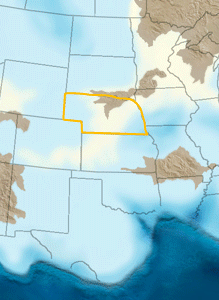
| 485 Ma |
Lower Ordovician Epoch
Shallow sea carbonate deposits of the late Cambrian continue into the early Ordovician (Oneota dolostone). Near the end of the Lower Ordovician Epoch, part of southeastern Nebraska was uplifted and subsequently eroded, causing an EROSIONAL GAP in the rock record.

470 Ma |
Middle Ordovician Epoch
In the Middle Ordovician, the seas advance across the low-relief landscape of Cambrian and Lower Ordovician carbonate rocks, leaving behind a thin beach sand. The St. Peter Sandstone (which is present in many Midwestern states) is deposited at this time. It's a very pure sandstone, consisting of uniform-sized quartz grains with little cement. This sandstone is porous and permeable, making it a good reservoir for petroleum or natural gas.

450 Ma |
Upper Ordovician Epoch
As the waters became deeper, the sands were buried by another carbonate unit called the Viola Formation. Both the St. Peter Sandstone and Viola Formation have produced some oil within the southern portion of the state.